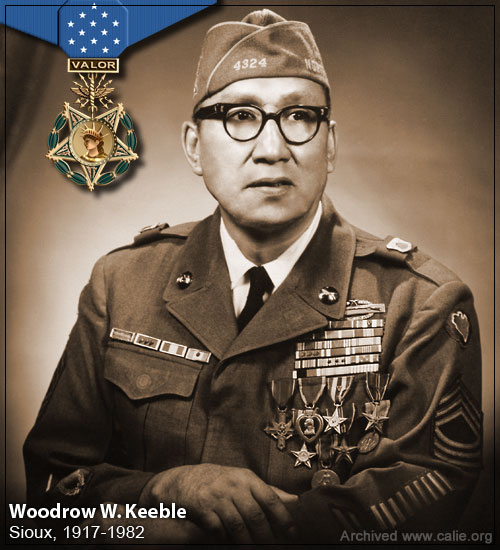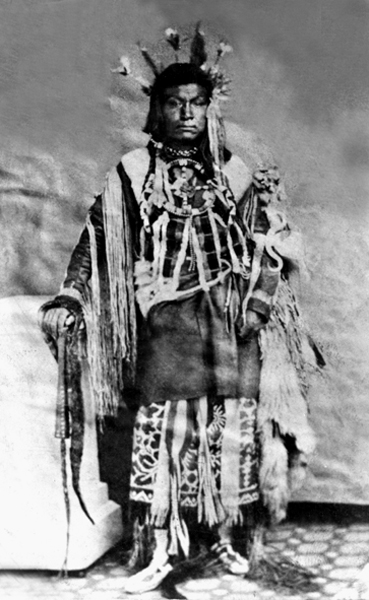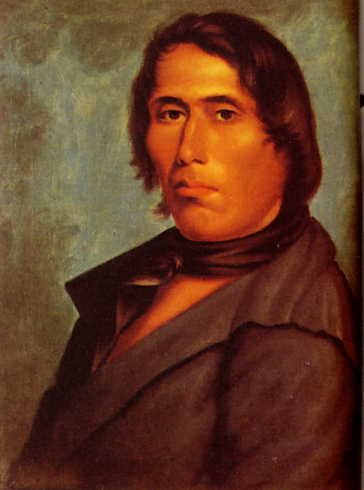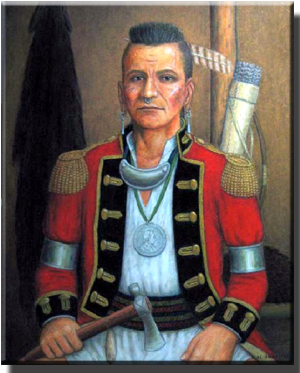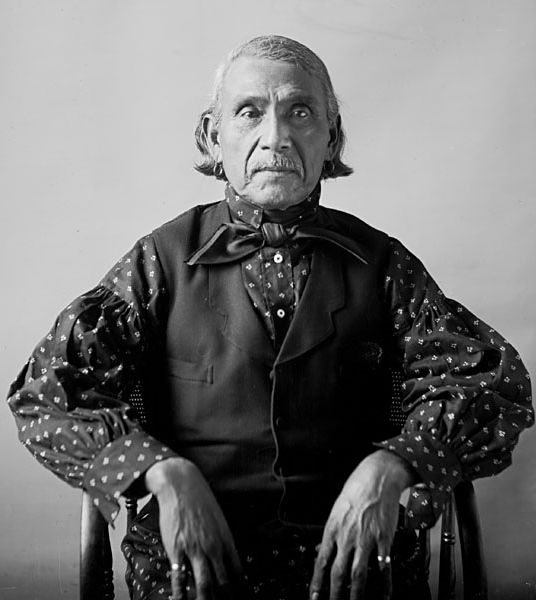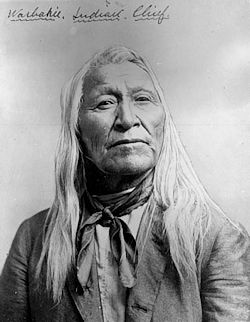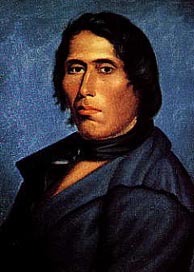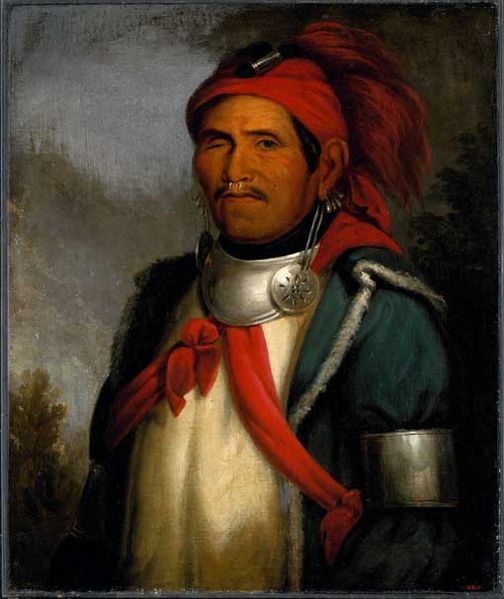In the 20th century, at least nine American Indians have been among those warriors to be distinguished by receiving the United States’ highest military honor: the Medal of Honor. Given for military heroism “above and beyond the call of duty,” these warriors exhibited extraordinary bravery in the face of the enemy and, in two cases, made the ultimate sacrifice for their country.
Famous Chiefs / Leaders
There were many kinds of native american chiefs and leaders. Usually they did not have absolute power over all situations or activities, and often various terms for leaders were used interchangeably. One could escape the power of a chief or leader by simply moving to another locality. Traditionally, a chief did not usually rule all bands or branches of a particular tribe.
Kinds of Chiefs
Cacique or Cazique (female form: Cacica) – A title derived from the Taíno word for the pre-Columbian chiefs or leaders of tribes in the Bahamas, Greater Antilles, and the northern Lesser Antilles. Following their first encounters with the Taino upon their arrival in the New World, the Spanish used the word as a title for the leaders of the other American tribes they encountered, predominantly in Latin America.
Chieftain may refer to the leader or head of a group, such as:
a tribal chief or a village head.
a member of the ‘House of chiefs’
a captain, to which ‘chieftain’ is etymologically related.
Clan chief
Chiefs of the Name – The recognised head of a family or clan.
Chief – May refer to:
Tribal chief – The head of a tribal form of self-government.
Chiefs of the Name -The head of a family or clan.
Paramount chief -The highest-level traditional chief or political leader in a regional or local polity or country typically administered politically with a chief-based system. This definition is used occasionally in anthropological and archaeological theory to refer to the rulers of multiple chiefdoms or the rulers of exceptionally powerful chiefdoms.
Historically, Paramount Chief is also more specifically a title created during the Colonial era by British administrators as a substitute for the word “king” in order to maintain that only the British monarch held that title.Since the title “chief” was already used in terms of district and town administrators, the addition of “paramount” was made so as to distinguish between the ruling monarch and the local aristocracy.
War Chief – Was the chief only for one particular war party, for as long as their mission lasted. He did not necessarily influence decisions in other aspects of their lives, although a War Chief was usually someone respected by the men of the tribe and could simultaneously hold other leadership positions or be elected as the War Chief of many subsequent raids and battles.
Hereditary Chief – A chief whose chiefdom is passed down from lineal descent, usually from a father to his oldest son, but not always. If a chief has no son, or the son is a fool, the line of descent may be to a son-in-law or nephew or younger son. Hereditary chiefs ruled extended family groups that lived together as a village.
Peace Chief – Usually someone with strong oratory skills, selected to speak for the people in situations where diplomacy is needed, such as during treaty negotiations. Many Peace Chiefs made trips to Washington to speak to Congress on behalf of their respective tribe.
House of chiefs – An assembly, either legislative or advisory, that is neither representative (by general elections) nor simply appointed and/or filled ex-officio, but consists of all or part of the traditional leaders, known as chiefs, of a country or polity. Historically, especially in colonial times, chiefs were often used as instruments of indirect rule, and/or convenient alternatives to elective institutions.
Sachem – Although “sagamore” has sometimes been defined by colonists and historians as a subordinate lord, modern opinion is that “sachem” and “sagamore” are dialectical variations of the same word.
Derived from the Proto-Eastern Algonquian sākimāw:
sâchim (Narragansett language – the source of the English word)
sakəma (Eastern Abnaki language – anglicised as Sagamore)
sakmow (Mi’kmaq language); plural sakmowk
sakom (Malecite-Passamaquoddy language)
sôgmô (Western Abnaki language)
Derived from the Proto-Central Algonquian hākimāw:
ogimaa (Anishinaabe language);written as ogimà in the Algonquin language, gimaa in the Ottawa language,wgema in the Potawatomi language; anglicised as Ogema.
uchimaa (Northern and Southern East Cree languages)
iiyuuchimaaw (Naskapi language)
Chair or Chairman – Today most modern tribes are ruled by an elected Tribal Council. The head of the tribal council may be called the Chair or Chairman or Chair Woman or Chair Person, instead of Chief.
Medicine Man (Medicine Woman, Medicine Person, Medicine Elder) – The primary function of the “medicine man,” (who is not always male), is to secure the help of the spirit world, including the Great Spirit, for the benefit of the entire community. The medicine man was not neccesarily the war chief or the political chief, although he could be, but did weld considerable influence in the decision making processes of his tribe.
Sometimes the help sought may be for the sake of healing disease, sometimes it may be for the sake of healing the psyche, sometimes the goal is to promote harmony between human groups or between humans & nature. So the term “medicine man” is not entirely inappropriate, but it greatly oversimplifies and also skews the depiction of the people whose role in society complements that of the chief.
To be recognized as the one who performs this function of bridging between the natural world and the spiritual world for the benefit of the community, an individual must be validated in his/her role by that community. Most medicine men and women study their art either through a medicine society such as the Navajo Blessingway, or apprentice themselves to a teacher for 20-35 years or both.Medicine People who heal physical ailments often have a specialty set of illnesses they treat, just as modern doctors do. While these medicine men are proficient in treating a specific set of ailments, spiritual and psychic elements are also usually part of the treatment. While in modern medicine, we usually treat the symptoms of an illness, in native American medicine the underlying cause is more often considered (including non-physical aspects that may cause illness) and every aspect of the whole person treated as needed.
Shaman (Shamanism) – A word often used by anthropologists interchangably to mean medicine people. In reality, shaman is a term that was not used by native american tribes, except some Alaskan Natives. The word ‘shaman’ has it’s origin in Russian culture. Shamanism is a range of traditional beliefs and practices concerned with communication with the spirit world. A practitioner of shamanism is known as a shaman.
There are many variations of shamanism throughout the world and several common beliefs are shared by all forms of shamanism. Shamans are intermediaries between the human and spirit worlds. According to believers, they can treat illness and are capable of entering supernatural realms to provide answers for human beings.
Kamiakin was an influential chief of the Yakama Tribe, a reluctant signer of the 1855 Walla Walla Treaty creating the Yakama Reservation, and one of the key war leaders during the Northwest’s Indian Wars of 1855-1858.
Tecumseh, Shawnee Chief
22 ViewsTecumseh was a Shawnee war chief who attempted to assemble a confederation of tribes to resist white settlement into the Ohio and Mississippi valleys in the early 1800s.
Chief Bluejacket, Shawnee
22 ViewsBlue Jacket or Weyapiersenwah (c. 1743 – c. 1810) was a war chief of the Shawnee people, known for his militant defense of Shawnee lands in the Ohio. He was noted chiefly as the principal leader of the Indian forces in the battle with General Wayne of August 20, 1794, at Presque Isle, Ohio.
Black Bob, Hathawekela Shawnee chief
22 ViewsBlack Bob (Wa-wah-che-pa-e-hai or Wa-wah-che-pa-e-kar) was a chief of the Hathawekela division of the Shawnee indian tribe. He was known for being one of the last Shawnee leaders to resist leaving for the Indian Territory, and for keeping his band together until his death, holding their lands in common, as they moved between Missouri, Arkansas, and the Black Bob Reservation in Kansas.
Big Jim, Absentee Shawnee leader
22 ViewsBig Jim was the popular name of a noted full-blood Shawnee leader, known among his people as Wapameepto, “Gives light as he walks”. His English name was originally Dick Jim, later corrupted into Big Jim. He was also known as White Road.
A federal judge in Pennsylvania ruled Friday that proceedings should begin to return the body of Olympic athlete Jim Thorpe to Oklahoma, a major step in a decades-long battle that Thorpe’s sons and the Sac and Fox tribe have waged to return his body to the place where he grew up.
TV Slur Revives Debate About Sacheen Littlefeather and Her Role in Marlon Brando’s Oscar Refusal
22 ViewsHistory was made in 1973 when Marlon Brando declined to accept the best actor Oscar for his role in The Godfather to protest the treatment of American Indians. His demurral, which was delivered on stage by a young Native American activist named Sacheen Littlefeather, generated intense controversy and criticism throughout the country. Almost 40 years later, some in Hollywood still seem to hold a grudge.
Throughout November, the nation will celebrate National American Indian Heritage Month. This year’s theme is “Serving Our People, Serving our Nations: Native Visions for Future Generations.”
On Nov. 11, Americans also will celebrate Veterans Day. Through these two observances, Americans can celebrate not only the significant contributions of American Indians and Alaska natives to our heritage and culture but also their contribution to this country’s defense.
In traditional Crow culture, warlike endeavors were key to becoming a chief and leader. Four acts of bravery and display were considered prerequisites for leadership; their achievement reflected divine guidance and grace. First, one had to be the first to strike or touch the enemy in battle. There could be only one first striker in a battle, and the race to attain that honor created the fury of the attack on the enemy.
Don Luis a.k.a. Opechancanough
25 ViewsOpechancanough or Opchanacanough (1543?-1644) was a tribal chief of the Powhatan Confederacy of what is now Virginia in the United States, and its leader from 1618 until his death in 1644. His name meant “He whose Soul is White” in the Algonquin language.
ENGLISH NAME: Little Carpenter
NATIVE NAME: Attakullakulia
MEANING OF NAME: Little Carpenter
ALTERNATE NAMES: Ukwaneequa, Chuconnunta, The Civil Chief, or White Chief
ALTERNATE SPELLINGS: Attacullaculla, Attakullaculla
SIGNIFICANT POSITIONS: Supreme Chief of the Cherokee 1760-1775
BIRTHPLACE / DATE: 1699, Big Island of the French Broad River, later called Sevier’s Island, TN
RESIDENCE: Tellico, and Chota, E. Indian Nation, TN
DEATH DATE / LOCATION: 1797, Nacheztown, North Carolina
BURIAL PLACE:
Oconostota, the Warrior of Chota
25 ViewsNATIVE NAME: Aganstata
ENGLISH NAME: James BEAVER Jr
ALTERNATE NAMES: Oconostota, Oconastota Moytoy, Cunne Shote, Warrior of Chota, Stalking Turkey (a name which causes confusion with his uncle Kanagatucko, who was known as “Standing Turkey”), Groundhog Sausage
ALTERNATE SPELLINGS: Oconastota, Oconostata, Oganatoga, Shote is a variant of Chote or Choat or Choate, Cumnacatogue
MEANING OF NAMES:
- Aganstata was translated as Groundhog Sausage, from “agana” = groundhog, and “tsistau” = “I am pounding it” as in pounding meat in a mortar.
- Cunne Shote may be the English mispronunciation of the Cherokee words for Stalking Turkey.
– Book Review: Nancy Ward was a well known historical figure from the Cherokee tribe born into the Wolf Clan around 1738 at Chota, near Fort Loudon, Tennessee. She was born around the time of a smallpox epidemic that caused the deaths of approximately half of the Cherokee population living at that time. Her father […]
American Horse, who succeeded to the name and position of an uncle who was killed in the battle of Slim Buttes in 1876, was one of the wittiest and shrewdest of the Oglala Sioux peace chiefs.
Wašíčuŋ Tȟašúŋke or American Horse (1840 – December 16, 1908) was a chieftain of the Oglala Sioux during the Sioux Wars of the 1870s. He was also the nephew of the elder American Horse and son-in-law of Red Cloud. A more literal translation of his Lakota name (Wašíčuŋ Tȟašúŋke) is He-Has-A-White-Man’s-Horse.
J.R. Cook, executive director of United National Indian Tribal Youth in Oklahoma City, believes Bradford is the first quarterback with American Indian heritage to start for a major college program since Sonny Sixkiller at Washington in 1972.
Albert Laughter is a fifth generation medicine man from the Navajo tribe. He has trained most of his life to treat the people of his tribe with traditional healing methods and natural herbs.
But these days, he is employed by the Federal Government to treat military veterans suffering from the trauma of combat.
On March 5, the Arizona Senate passed Senate Concurrent Resolution 1010 urging Congress to establish a new postage stamp honoring three groups of veterans who fought bravely for our country: The Tuskegee Airmen, the
Japanese American soldiers and the Navajo Code Talkers.
AUTHOR: Brenda Norrell American Indians are petitioning Congress to investigate the elite Skull and Bones society at Yale University and return the remains of Chiricahua Apache warrior Geronimo to Apaches for reburial. This article has permanently moved to Skull and Bones society at Yale University has Geronimo’s skull – Apaches want it back
Although it was discovered in the 1960s that the first Native American in the major leagues was James Madison Toy, who played in the American Association in 1887 and 1890, the first man known and treated as an American Indian was Louis Sockalexis, a member of the Penobscot tribe.Born on October 24, 1871 on the Penobscot Indian reservation outside of Old Town, Maine, Sockalexis displayed incredible athletic talent in his youth.
Mary Brave Bird dictated her life story in the two books Lakota Woman and Ohitika Woman to Richard Erdoes, a photographer and illustrator who himself became involved in political activism through having taped and transcribed her story. In these two books, written 15 years apart, Brave Bird told how the American Indian Movement (AIM) gave […]
Tegaquitha, “Lily of the Mohawks,” as she was popularly known, was the first recorded Native American Roman Catholic nun in North American. She was born in 1656 at Gandawague Castle near Fonda, New York, to a Mohawk father and a Christianized Algonquin mother of the Turtle clan. During her childhood, her parents and a younger brother died from smallpox, and she was left badly scarred and pockmarked orphan.
The widow of Totopotomoi, the Pamunkey chief, Queen Anne became the chief of the tribe following the death of her husband during the battle in which he supported the English against other Indian warriors.
Wilma Pearl Mankiller was both the first woman deputy chief and the first woman principal chief of the Cherokee Nation of Oklahoma.
Kéhachiwinga, “Wolf’s Mountain Home Maker,” was a Winnebago woman who was the subject of a remarkable autobiography account written down by Nancy Lurie, in 1958, and subsequently published in book form as Mountain Wolf Woman, Sister of Crashing Thunder: The Autobiography of a Winnebago Indian – a notable contribution to the literature of culture change and personality.
Kéhachiwinga was selected by Dr. Lurie, in part, because her brother Hágaga had been interviewed by Paul Radin, and that account was published in an equally well-received book, Crashing Thunder. The comparison and contrast between the two provided a valuable insight into the life of one Indian family.
Maria Tallchief, Osage (1925- )
22 ViewsMaria Tallchief became the first American trained ballerina of international importance.
Pocahontas, Pamunkey(1595?-1617)
22 ViewsFrom Algonquin pocahantesu, “She is Playful”, although another translation suggests “Bright Stream Between Two Hills”. Pocahontas’ Pamunkey name was Mataoaka (also spelled Matoax and Matowaka), “She Plays with Things”; both names apparently referring to her vivacious disposition. The exact date pf her birth is not clear; it is said to have been between 1595-1597, but the earlier date is preferred by most writers. It is certain that she was the favorite daughter of Powhatan, the powerful chief of the Virginia confederacy.
Susan La Flesche, Sioux (1865-1915)
22 ViewsSusan La Flesche was the first female Indian physician. She was born into the Sioux Nation in 1865 and graduated from the Women’s Medical College of Pennsylvania.
Wawa Calac Chaw, “Keep From the Water,” was a writer, artist, and lecturer on Indian and feminist matters. She was born on December 25, 1888 at Valley Center in the Tule River area of California.
From the English rendition of Nanye-hi, “One Who Goes About,” named from the mythological Spirit People, Nancy Ward was a major Cherokee figure of the Southern frontier who became an almost legendary person due largely to her queenly manner and resolute personality. Nanye-hi was born into the Wolf clan about 1738 at Chota, near Fort […]
Sacajawea is one of the most famous native american women in American History. Sacajawea was an interpreter for, and the only woman on the Lewis and Clark Expedition of 1804-1806. Sacajawea (more accurately Sacagawea, possibly from the Hidatsa word tsakakawia, is usually translated to English as “Bird Woman.”
Sacagawea was born into the Shoshoni tribe in the Rocky Mountains. The exact date has been variously reported as 1784 and 1788. Her Shoshoni name was Boinaiv, meaning “Grass Maiden.”
Angel DeCora Dietz
Born in 1871 on the Winnebago reservation in Nebraska, Angel DeCora Dietz was influential in shaping of Indian art and affairs in the early years of the 20th century.Angel DeCora Dietz graduated from the Hampton Institute in 1891 and studied art at Smith College, the Drexel Institute and at the Boston Museum of Fine Arts.
The following is Charles Eastman’s account of Chief Sitting Bull. If the Great Spirit had desired me to be a white man he would have made me so in the first place. He put in your heart certain wishes and plans, and in my heart he put other and different desires. It is not necessary […]
For most modern Wyoming residents and many historians of the American West, the names of Chief Washakie, the Shoshone Indians, and the Wind River Reservation seem inseparable. Yet, it was not always so. The Eastern Shoshone band of American Indians, for whom the Wind River Reservation was created by the Fort Bridger Treaty of 1868, represents an amalgam of various bands of Shoshone and Bannock peoples, most of whom originate from Nevada, Utah, and Idaho, not Wyoming.
Washakie, the best-known leader of the Eastern Shoshones in the latter part of the 19th century, is still considered by some Shoshones as an outsider because he was not a full-blood Shoshone.Indeed, Washakie was of mixed tribal heritage.
AUTHOR: Stan Griffin The Pilgrims arrived in the New World in 1620. Before they had chosen a suitable site for their settlement, it was late in December. On Christmas Day, the first work party went on shore. Houses were built, and streets were laid out. The winter was an ordeal for the Pilgrims. Over […]
Tenskwatawa was one of a set of triplets born a few years after Tecumseh. One triplet, Sauwaseekau, was killed at the Battle of Fallen Timbers; the second, Kumskaukau, may have died young, for there are no records of his life; and the third, who would eventually be known as Tenskwatawa, was a fussy baby who was given the name Lalawethika – He Makes a Loud Noise
Later in life, he would be known as the Shawnee Profit.
Tenskwatawa was one of a set of triplets born a few years after Tecumseh. One triplet, Sauwaseekau, was killed at the Battle of Fallen Timbers; the second, Kumskaukau, may have died young, for there are no records of his life; and the third, who would eventually be known as Tenskwatawa, was a fussy baby who was given the name Lalawethika – He Makes a Loud Noise.
Tenskwatawa, the brother of Tecumseh, was best known as a powerful medicine man known as the Shawnee Prophet. Once named Lalawthicka which means “He who makes a loud noise” due to his habit of bragging about himself, this man was given the new name of Tenskwatawa which means “The Open Door” after having a vision of heaven.
The Freedmen: James Coody Johnson
22 ViewsThe Freedmen: James Coody Johnson … KEYWORDS:James Coody Johnson freedmen black indians black creek freedmen black indian leader freemen who lived with Indians creek indian history Oklahoma Freedmen African-Native people green peach war Seminole Freedmen A significant number of Afro-Americans were sold, escaped or fled from slavery and eventually settled in the West, where they […]
The Freedmen:John Myers, Creek Lighthorseman … KEYWORDS: john myers creek lighthorseman freedmen black indians black creek freedmen black indian leader freemen who lived with Indians creek indian history Oklahoma Freedmen African-Native people green peach war A significant number of Afro-Americans were sold, escaped or fled from slavery and eventually settled in the West, where they […]
The Freedmen:Sugar T. George a.k.a. George Sugar … KEYWORDS: Sugar T. George a.k.a. George Sugar freedmen black indians black Muskogee Nation black indian leader freemen who lived with Indians Muskogee Nation indian history Oklahoma Freedmen African-Native people A significant number of Afro-Americans were sold, escaped or fled from slavery and eventually settled in the West, […]
The Freedmen: Silas Jefferson
22 ViewsThe Freedmen: Silas Jefferson … KEYWORDS:Silas Jefferson freedmen black indians black Muskogee Nation black indian leader freemen who lived with Indians Muskogee Nation indian history Oklahoma Freedmen African-Native people green peach war A significant number of Afro-Americans escaped or fled from slavery and eventually settled in the West, where they were adopted by Indian tribes […]
The Freedmen: John Horse, adviser to Osceola … KEYWORDS: John Horse freedmen black indians black Seminole wars black indian leader freemen who lived with Indians black adviser to Osceola Florida indian history Oklahoma Freedmen African-Native people A significant number of Afro-Americans escaped or fled from slavery and eventually settled in the West, where they were […]
The Freedmen: Harry Island was an official U.S. Interpreter for the Muskogee Creek Nation … KEYWORDS: Caesar Bruner freedmen black indians black Muskogee Creek Nation black indian leader freemen who lived with Indians Muskogee Creek Nation leaders nuskogee creek indian history A significant number of Afro-Americans escaped or fled from slavery and eventually settled in […]
The Freedmen: Caesar Bruner was born in Indian Territory as a free man … KEYWORDS: Caesar Bruner freedmen black indians black seminoles black indian leader freemen who lived with Indians Seminole leaders seminole indian history seminole nation Bruner band A significant number of Afro-Americans escaped or fled from slavery and eventually settled in the West, […]
The Freedmen: Dosar Barkus was a leader in a Black Seminole community … KEYWORDS: Dosar Barkus freedmen black indians black seminoles black indian leader slaves who lived with Indians Seminole leaders seminole indian history seminole nation Sasakwa, Indian Territory A significant number of Afro-Americans escaped or fled from slavery and eventually settled in the West, […]
The Freedmen: Abraham the African Seminole Leader… KEYWORDS: freedmen black indians seminole leader abraham black indian leaders slaves who lived with Indians A significant number of Afro-Americans escaped or fled from slavery and eventually settled in the West, where they were adopted by Indian tribes and accepted into the tribal structure as equals. Many even […]
Do you know this modern day hero?
22 ViewsDo you know this modern day hero?.. KEYWORDS: native american veteran medic Viet Nam modern day hero looking for veteran who served in Vietnam as a medic ‘ AUTHOR: Slater Davis Click to enlarge I am looking for my platoon medic who served in Vietnam with 4th Platoon, Co.B, 4th Bn, 21st Inf, Americal Divsion, […]
How Sitting Bull got his names
22 ViewsSitting-Bull was a Dakota Indian from the Hunkpapa Band and a respected medicine man. The word Dakota means united by compact, and there were several united tribes who collectively called themselves the Dakotas. Sitting Bull was born near an old army station, Fort George, on Willow Creek, and his father was Jumping Bull. Read the […]
winema Winema famous native american women native american woman of note kaitchkona winema strong hearted woman little woman chief female subchief Modoc war of 1872-1873 Winema Toby Riddle Scarface Charlie Secot Frank Riddle Kintpuash General Edward Canby Nonooktowa strange child kitchkani laki shnawedsh famous modoc woman famous indian woman famous american indian woman 1800s lecture-play […]
